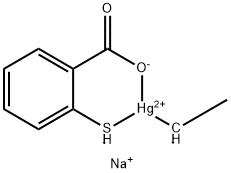PHENYLMERCURIC BORATE
- CAS NO.:102-98-7
- Empirical Formula: C6H7BHgO3
- Molecular Weight: 338.52
- MDL number: MFCD00019938
- EINECS: 203-068-1
- SAFETY DATA SHEET (SDS)
- Update Date: 2024-12-18 14:08:57

What is PHENYLMERCURIC BORATE?
Chemical properties
Phenylmercuric borate occurs as colorless, shiny flakes or as a white or slightly yellow, odorless, crystalline powder.
Production Methods
Phenylmercuric borate may be prepared by heating mercuric borate with benzene or by evaporating to dryness, under vacuum, an alcoholic solution containing equimolar proportions of phenylmercuric hydroxide and boric acid.
Pharmaceutical Applications
Phenylmercuric borate is used as an alternative antimicrobial preservative to phenylmercuric acetate or phenylmercuric nitrate. It is more soluble than phenylmercuric nitrate and has also been reported to be less irritant than either phenylmercuric acetate or phenylmercuric nitrate.
Safety
Phenylmercuric borate is mainly used as an antimicrobial preservative
in topical pharmaceutical formulations. A number of
adverse reactions to mercury-containing preservatives have been
reported; see Phenylmercuric Nitrate.
Although phenylmercuric borate is an irritant, it has been
reported to be less so than either phenylmercuric acetate or phenylmercuric nitrate.(1) There is, however, some cross-sensitization
potential with other mercurial preservatives.
Systemic absorption has been reported following regular use of a
hand disinfectant soap containing 0.04% phenylmercuric borate,
resulting in an increase in the estimated total daily body load of
mercury from 30–100 mg per 24 hours.
storage
As for other phenylmercuric salts; see Phenylmercuric Nitrate.
Solutions may be sterilized by autoclaving.
Phenylmercuric borate should be stored in a well-closed
container, protected from light, in a cool, dry place.
Incompatibilities
Incompatible with: halides; anionic emulsifying agents and
suspending agents; tragacanth; starch; talc; sodium metabisulfite;
sodium thiosulfate; disodium edetate; silicates; aluminum and other
metals; amino acids; ammonia and ammonium salts; sulfur
compounds; rubber; and some plastics.
Phenylmercuric acetate is reported to be incompatible with
cefuroxime and ceftazidime.
Regulatory Status
Included in nonparenteral medicines licensed in Europe. Included in
the Canadian List of Acceptable Non-medicinal Ingredients
(ophthalmic, nasal and otic preparations up to 0.004%; there
must be no other suitable alternative preservative).
In Europe, use is limited to eye makeup and eye makeup remover
at not more than 0.007% mercury alone or in combination with
other permitted mercurial substances.In France, a maximum
concentration of up to 0.01% is permitted for use in pharmaceutical
formulations. Prohibited from use in cosmetic products in Canada.
Prohibited in antimicrobial diaper rash drug products in the USA.
Limited use in Japan (see Phenylmercuric Nitrate).
Properties of PHENYLMERCURIC BORATE
| Melting point: | 112-113° |
| form | solid |
| CAS DataBase Reference | 102-98-7(CAS DataBase Reference) |
| EPA Substance Registry System | Mercurate(2-), [orthoborato(3-)-.kappa.O]phenyl-, dihydrogen (102-98-7) |
Safety information for PHENYLMERCURIC BORATE
Computed Descriptors for PHENYLMERCURIC BORATE
New Products
(S)-3-Aminobutanenitrile hydrochloride 4-Methylphenylacetic acid N-Boc-D-alaninol N-BOC-D/L-ALANINOL Tert-butyl bis(2-chloroethyl)carbamate 3-Morpholino-1-(4-nitrophenyl)-5,6-dihydropyridin- 2(1H)-one Furan-2,5-Dicarboxylic Acid Tropic acid 1-Bromo-3,5-Di-Tert-Butylbenzene S-2-CHLORO PROPIONIC ACID ETHYL ISOCYANOACETATE 2-Bromo-1,3-Bis(Dimethylamino)Trimethinium Hexafluorophosphate 4-IODO BENZOIC ACID 3-NITRO-2-METHYL ANILINE 1-(2,4-DICHLOROPHENYL) ETHANAMINE (2-Hydroxyphenyl)acetonitrile 4-Bromopyrazole 2-(Cyanocyclohexyl)acetic acid 4-methoxy-3,5-dinitropyridine 1-(4-(aminomethyl)benzyl)urea hydrochloride 2-aminopropyl benzoate hydrochloride diethyl 2-(2-((tertbutoxycarbonyl)amino) ethyl)malonate tert-butyl 4- (ureidomethyl)benzylcarbamate Ethyl-2-chloro((4-methoxyphenyl)hydrazono)acetateRelated products of tetrahydrofuran








You may like
-
 Phenyl mercuric borate CAS 102-98-7View Details
Phenyl mercuric borate CAS 102-98-7View Details
102-98-7 -
 2033-24-1 98%View Details
2033-24-1 98%View Details
2033-24-1 -
 1975-50-4 98%View Details
1975-50-4 98%View Details
1975-50-4 -
 2-HYDROXY BENZYL ALCOHOL 98%View Details
2-HYDROXY BENZYL ALCOHOL 98%View Details
90-01-7 -
 2-Chloro-1,3-Bis(Dimethylamino)Trimethinium Hexafluorophosphate 221615-75-4 98%View Details
2-Chloro-1,3-Bis(Dimethylamino)Trimethinium Hexafluorophosphate 221615-75-4 98%View Details
221615-75-4 -
 61397-56-6 CIS BROMO BENZOATE 98%View Details
61397-56-6 CIS BROMO BENZOATE 98%View Details
61397-56-6 -
 14714-50-2 (2-Hydroxyphenyl)acetonitrile 98+View Details
14714-50-2 (2-Hydroxyphenyl)acetonitrile 98+View Details
14714-50-2 -
 118753-70-1 98+View Details
118753-70-1 98+View Details
118753-70-1